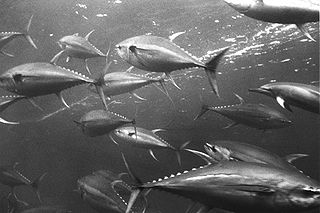
The mackerel, tuna, and bonito family, Scombridae, includes many of the most important and familiar food fishes. The family consists of 51 species in 15 genera and two subfamilies. All species are in the subfamily Scombrinae, except the butterfly kingfish, which is the sole member of subfamily Gasterochismatinae.

Pseudoscorpions, also known as false scorpions or book scorpions, are small, scorpion-like arachnids belonging to the order Pseudoscorpiones, also known as Pseudoscorpionida or Chelonethida.
Neoliotomus is a genus of North American mammal from the Paleocene. It existed in the age immediately following the extinction of the last dinosaurs and was a member of the extinct order Multituberculata. It lies within the suborder Cimolodonta and the superfamily Ptilodontoidea. Other than that, its affinities are somewhat unclear.
Microcosmodon is a mammal genus from the Paleocene of North America. It was a member of the extinct order Multituberculata, and lies within the suborder Cimolodonta and family Microcosmodontidae. The genus Microcosmodon was named by G.L. Jepsen in 1930.

Alcide Charles Victor Marie Dessalines d'Orbigny was a French naturalist who made major contributions in many areas, including zoology, palaeontology, geology, archaeology and anthropology.

Dolichoderinae is a subfamily of ants, which includes species such as the Argentine ant, the erratic ant, the odorous house ant, and the cone ant. The subfamily presents a great diversity of species throughout the world, distributed in different biogeographic realms, from the Palearctic, Nearctic, Afrotropical region and Malaysia, to the Middle East, Australian, and Neotropical regions.
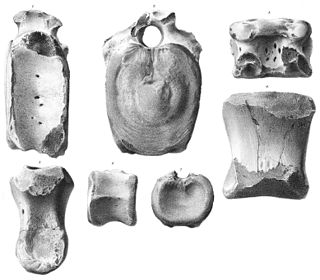
Thespesius is a dubious genus of hadrosaurid dinosaur from the late Maastrichtian-age Upper Cretaceous Lance Formation of South Dakota.

Talpa is a genus in the mole family Talpidae. Among the first taxa in science, Carolus Linnaeus used the Latin word for "mole", talpa, in his Regnum Animale to refer to the commonly known European form of mole. The group has since been expanded to include 13 extant species, found primarily in Europe and western Asia. The European mole, found throughout most of Europe, is a member of this genus, as are several species restricted to small ranges. One species, Père David's mole, is data deficient. These moles eat earthworms, insects, and other invertebrates found in the soil.
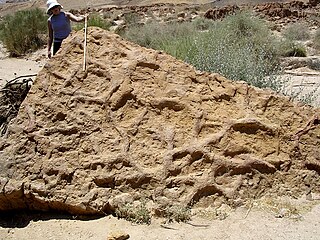
An ichnotaxon is "a taxon based on the fossilized work of an organism", i.e. the non-human equivalent of an artifact. Ichnotaxon comes from the Ancient Greek ἴχνος (íchnos) meaning "track" and English taxon, itself derived from Ancient Greek τάξις (táxis) meaning "ordering".
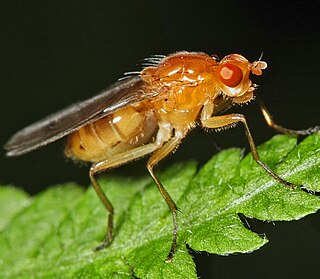
The Dryomyzidae are a small family of flies ranging from 4–18 mm long, with prominent bristles, and yellow to brown or rust-yellow coloring. The wings are very large. The subcosta is complete and well separated from vein 1. Larvae feed on decaying organic matter - carrion, dung, and fungi. The prelambrum protrudes from the oral cavity. Vibrissae are absent and the postvertical bristles are divergent.

Elaphurus is a genus of deer. E.davidianus is the only extant species and several fossil species are described.
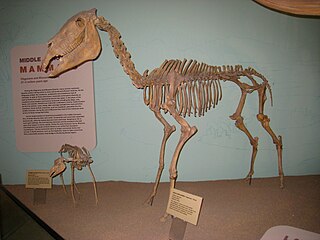
Equus simplicidens, sometimes known as the Hagerman horse or the American zebra is an extinct species in the horse family native to North America during the Pliocene and Early Pleistocene. It is one of the oldest and most primitive members of the genus Equus. It is the state fossil of Idaho, where its abundant remains were discovered in 1928, specifically in Hagerman, Idaho. They are also known from other US states including Arizona, California, Texas, Nebraska and Kansas.
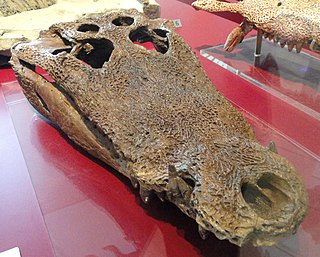
Leidyosuchus is an extinct genus of alligatoroid from the Late Cretaceous of Alberta. It was named in 1907 by Lawrence Lambe, and the type species is L. canadensis. It is known from a number of specimens from the middle Campanian age Dinosaur Park Formation. It was a medium-sized alligatoroid, with a maximum skull length greater than 40 centimeters (16 in).
The Canthyloscelidae are a small family of midges closely related to the Scatopsidae.

Lydekkerina is an extinct genus of stereospondyl temnospondyl. It is the type genus of the family Lydekkerinidae. Fossils have been collected from Early Triassic deposits in South Africa and Australia. The type species is L. huxleyi, first described in 1889. While most other stereospondyls were semiaquatic, Lydekkerina was exclusively terrestrial.
Listrognathosuchus is an extinct genus of alligatoroid crocodilian. Fossils date back to the middle Paleocene epoch. In 1997, the generic name replaced that of Leidyosuchus for the species L. multidentatus. "L." multidentalis was first described by Charles Mook in 1930 on the basis of the holotype AMNH 5179, consisting of a partial vertebral column, mandible, partial left ilium, and left tibia, found from a locality in Torrejon Arroyo, New Mexico.
Eusauropleura is an extinct genus of gephyrostegid reptiliomorph from the Pennsylvanian of Linton, Ohio. The type species and only species, Eusauropleura digitata, was first described by American paleontologist Edward Drinker Cope in 1868 as Sauropleura digitata. In 1930, paleontologist Alfred Romer placed the species in the new genus Eusauropleura. Romer considered S. digitata to be a reptile or a more primitive relative of reptiles, making it only distantly related to Sauropleura, which is a lepospondyl amphibian.

Eulithomyrmex is an extinct genus of ant in the formicid subfamily Agroecomyrmecinae. The genus contains two described species, Eulithomyrmex rugosus and Eulithomyrmex striatus. Eulithomyrmex is known from a group of Late Eocene fossils which were found in North America.
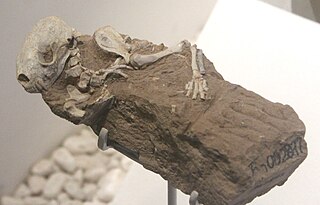
Promephitis is an extinct genus of mephitid, of which several species have been described from the Miocene and early Pliocene of Europe and Asia.

Smitanosaurus is a genus of dicraeosaurid sauropod dinosaur from the Late Jurassic of Colorado. The genus contains one species, S. agilis, originally assigned to the defunct genus Morosaurus.















